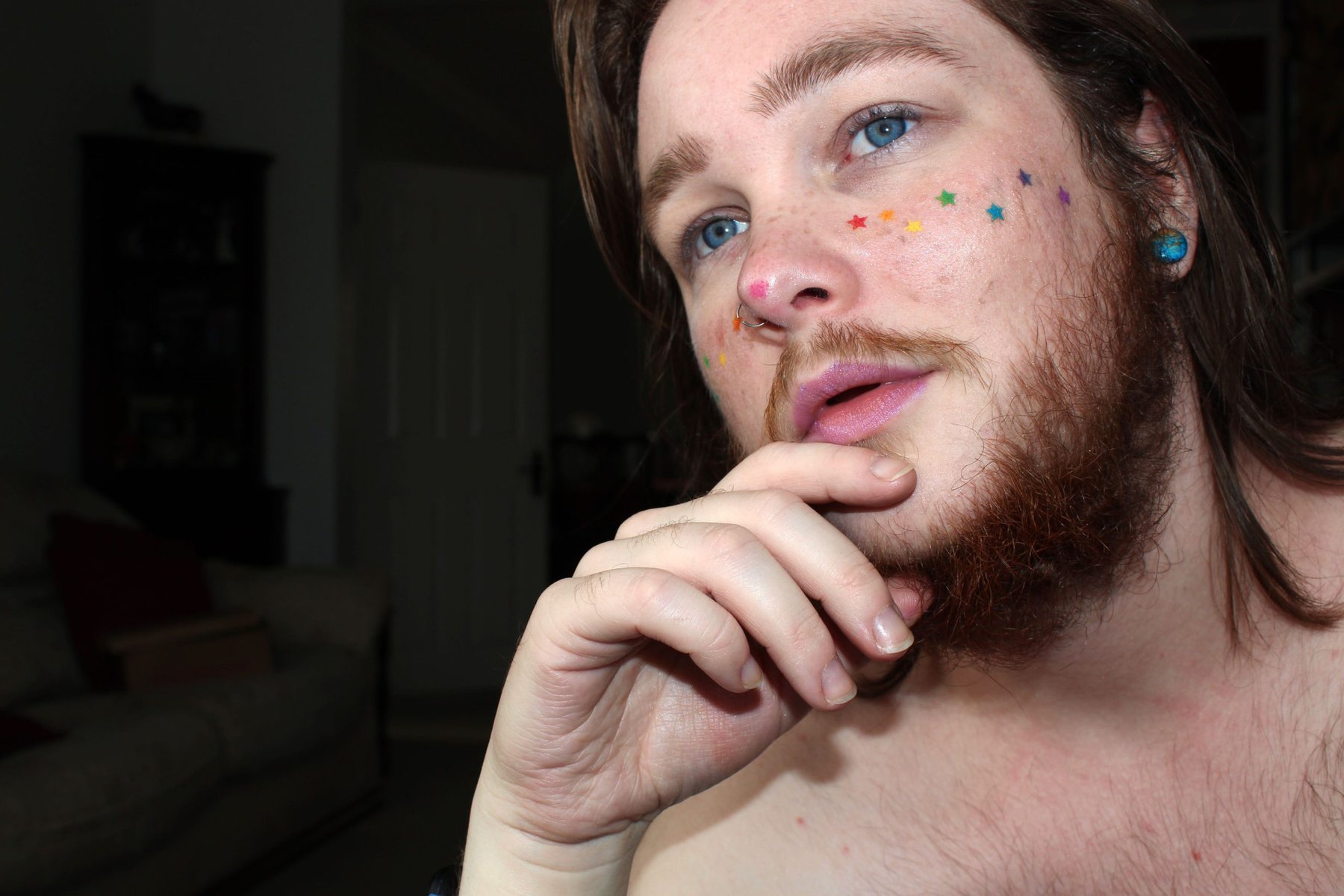Masculinising hormone therapy is the term we use to describe gender-affirming hormone treatments that we offer to transgender and gender-diverse people who would like to change their bodily appearance and/or appear more traditionally “masculine”.
Masculinising hormone therapy is just one of the options available that allow people assigned female at birth (AFAB) to feel more comfortable in their bodies, relieve gender dysphoria, and/or change the way they look and sound to better match their gender identity.
Who is masculinising hormone therapy for?
Masculinising hormone therapy is for anyone assigned female at birth (AFAB) who wants to appear more masculine, no matter their gender or presentation. Whether you’re a transgender man, non-binary, genderqueer, agender, gender expansive, or gender nonconforming in numerous other ways.
That said, it’s important to emphasise that trans people do NOT need to medically or surgically transition in order to be trans. If you’re trans and can’t (or don’t want to) medically transition (no matter the reason), you are 100% valid.
How does masculinising hormone therapy work?
Masculinising hormone therapy consists of taking a medication called testosterone. Testosterone is the “male” sex hormone that is responsible for developing traditionally “masculine” secondary sex characteristics like having facial hair, a deeper voice and more muscle mass.
When a person assigned female at birth (AFAB) takes testosterone, it increases the testosterone levels in their blood, which also then suppresses their oestrogen (or “female”) hormone levels. These hormone changes can then trigger physical changes that can help better align the body with a person’s gender identity. No additional medications are necessary to suppress oestrogen, since testosterone is able to do this alone.
What are the requirements for starting masculinising hormone therapy?
Gender affirming healthcare is (and should be) based on an informed consent model. This means that the healthcare provider and client share in the decision making process after discussing all of the risks and benefits of hormone therapy.
The informed consent model recognises that the client is the expert of their own needs and experience, while respecting that the healthcare provider needs to utilise their expertise to enable safe and effective treatment.
Masculinising hormone therapy does not need to be prescribed or monitored by an endocrinologist. Prescribing hormone therapy is well within the realm of a suitably skilled general practitioner (GP).
That said, the requirements for starting masculinising hormone therapy include:
- A desire to use masculinising hormone therapy.
- Persistent gender incongruence between one’s experienced and assigned gender.
- Capacity to make a fully informed decision and consent to treatment.
- The decision is made of your own free will.
You do NOT need to have a referral letter from a mental health professional. Seeing a psychologist is not a requirement for initiating masculinising hormone therapy. While previously, some healthcare providers required a letter of diagnosis or referral, this is no longer necessary under international best practice.
What effects can you expect from masculinising hormone therapy?
The changes you will experience while on masculinising hormone therapy often take some time to fully develop. Some of these changes are reversible and will disappear if you stop taking the hormones, while other changes are irreversible and will persist even if you stop taking your hormones.
The timeline for these changes to begin is variable, but most effects will only reach their maximum degree after 3–5 years on hormone therapy.
Reversible changes include:
- Increased muscle mass and increased strength.
- Changes in body fat distribution, possibly associated with weight gain (increased fat deposition in the abdomen, and decreased fat in the chest, bum and thighs).
- Coarser and thicker skin.
- Increased skin oiliness and acne.
- Coarser and thicker body hair.
- Increased red blood cell count.
- Increased libido.
- Changes in mood and emotional responses.
- Cessation of ovulation and menstruation/bleeding cycles.
- Dryness of the genital tissues.
Irreversible changes include:
- Hair loss or male pattern balding.
- Facial hair growth.
- Deepening of the voice.
- Enlargement of the clitoris.
- Infertility.
The extent to which changes can be reversible depends on how long you take the hormones for, the dosage you used, and how responsive your body was to the hormones.
The table below shows the different effects of masculinizing hormone therapy and the estimated time it takes to see the changes:
| Effects | Time from initiation to onset | Time from initiation to maximum effect | Reversible? |
| Skin oiliness and acne | 1–6 months | 1–2 years | Yes |
| Facial and body hair growth | 6–12 months | 4–5 years | No |
| Scalp hair loss | 6–12 months | Unknown | No |
| Increased muscle mass and strength | 6–12 months | 2–5 years | Yes |
| Fat redistribution | 1–6 months | 2–5 years | Yes |
| Cessation of menses | 2–6 months | N/A | Possibly |
| Clitoral enlargement | 3–6 months | 1–2 years | No |
| Vaginal atrophy | 3–6 months | 1–2 years | Yes |
| Deepening of voice | 6–12 months | 1–2 years | No |
| Changes in libido and sexual response cycle | 1–3 months | Unknown. You may experience changes in sexual desire and arousal. Libido can increase dramatically as testosterone levels increase, but usually settles as the body gets used to the new “normal”. | Yes |
Please note: When taking masculinising hormone therapy, it’s important to have realistic expectations regarding the effects that hormones can have on your body. Everyone is different and will react differently to hormones for a variety of reasons.
What are the different types of testosterone preparations available in South Africa?
| Type | Examples | Advantages | Disadvantages |
| Short-acting injection (once a week) | Depo-testosterone | Accessible at most pharmacies. Affordable. Once-a-week dosing. | Requires knowledge of injection technique. Requires syringes, needles and alcohol swabs. Stock shortages may be a problem. |
| Long-acting injection (once every 10-12 weeks) | Nebido | Accessible at most pharmacies. A single dose lasts approximately 3 months. | Requires knowledge of injection technique. Requires syringes, needles and alcohol swabs. Achieving the correct dose can be difficult with long dosing intervals. More expensive. |
| Transdermal (topical gels or creams) | Androgel or compounded creams. | No injection needed. Androgel is accessible from most pharmacies. Good option for those who prefer lower doses. | Compounded custom strength testosterone creams available only from compounding pharmacies. Skin absorption varies between clients. Can unintentionally be transferred onto other people or animals. |
Please note: We do not prescribe oral testosterone or testosterone pills in South Africa due to safety concerns.
During your consultation, you can discuss the various options for masculinising hormone therapy with your doctor, and decide which form of treatment is best for you.
How much does masculinising hormone therapy cost?
It’s important to remember that not only do different people have different needs when it comes to hormone therapy, but also that prices for medication may vary and fluctuate over time.
The majority of people can expect to spend R300–R900 per month on masculinising hormone therapy, depending on the form and dose of testosterone. This doesn’t include the cost of blood tests or doctor’s visits.
What are the risks and side effects of masculinising hormone therapy?
As with any medication, masculinising hormone therapy carries with it certain risks and side effects. Some of these risks can be mitigated or reduced by lifestyle factors, while others are independent risks that cannot be altered.
According to the latest research, the biggest concern with testosterone therapy is the risk of liver and cardiovascular disease. This is one of the main reasons why you will require regular follow-up visits and blood tests when taking hormones.
Side effects and risks include:
- Increased cholesterol: This increases your risk of heart attacks or strokes to levels similar to cisgender men.
- Polycythaemia: This is when you have too many red blood cells in your blood, so your blood becomes too thick. This can increase your risk of having blood clots, heart attacks and strokes.
- Androgenic alopecia: This is also known as male pattern hair loss or balding.
- Sleep apnoea: This is a sleep disorder where breathing is interrupted during sleep.
- Psychiatric symptoms: This includes mood disturbances, anxiety or psychosis, especially if there are pre-existing mental health conditions.
- Acne.
- Headaches.
- Changes in appetite and/or weight gain.
- Loss of fertility.
- Taste changes.
- Body odour changes.
- Changes in sleep.
- Clitoral discomfort.
Masculinizing hormone therapy also puts you at an increased risk of:
- Liver disease and elevated liver enzymes
- High cholesterol
- Hypertension
- Type 2 diabetes
All of the above can lead to, or worsen, cardiovascular disease or lead to heart attacks and strokes.
Do I still need to take contraception or birth control to prevent pregnancy?
Yes. Hormone therapy is not a replacement for effective and responsible contraceptive use, even if you are on high doses of testosterone and your bleeding cycles have stopped.
It’s very important that you use contraception if there is any possibility of conception with your partner. If you have a uterus, and are having receptive vaginal/front hole sex with a person who produces sperm, then you could still get pregnant.
Remember: Even if your partner withdraws or just ejaculates externally on your genitals, you can still get pregnant.
If you do get pregnant, you’ll have to stop your hormone therapy immediately and go for testing because testosterone is teratogenic, this means that it can cause foetal abnormalities or birth defects.
That said, some people on masculinising hormone therapy may become infertile. Some might regain fertility after stopping hormone therapy, while others may become irreversibly infertile. Unfortunately we cannot predict how each individual will react.
If there’s any possibility that you may want to have biological children at some point in the future, then the safest thing to do is to use a cryobank to preserve genetic material for future use.
Is it possible to stop my monthly bleeding cycles?
Yes. Bleeding cycles (or menstrual cycles) can cause a lot of distress for transgender and gender-diverse people. Testosterone can stop your bleeding cycles, but usually this only happens once you’ve been taking it for 6-12 months and you’ve reached high enough testosterone levels.
If you’re taking testosterone and you’re still getting your monthly bleeding cycle, we can temporarily suppress it with another hormone called progesterone, using progesterone-only contraceptive methods.
Progesterone-only contraceptives can stop your bleeding cycles whether you’re taking testosterone or not. So if you don’t feel ready for testosterone therapy yet, and you want to stop your monthly cycles, you can use this method too.
Is it possible to control how much masculinisation I want?
Yes and no. Unfortunately, we cannot predict how your body will react to testosterone therapy before you start it. For example: some people can grow facial hair easily and have a full thick beard when taking high doses of testosterone, while others may only develop a thin patchy beard even after many years on testosterone – just like cisgender men. Everyone is different and genetics play a large role in how your body responds to testosterone.
However, we can control the dose of testosterone. This means that you can use very low doses of testosterone to get smaller changes, if this is something you want. You can also take testosterone temporarily until you see the changes you want and stop it again. In this way, you can control how much masculinisation you develop.
That said, unfortunately, you cannot pick and choose which effects you want and don’t want. For example: you cannot choose to have facial hair and more muscle mass, but not get bottom growth or hair loss. This is why it’s so important to discuss your goals and expectations with your doctor before starting masculinising hormone therapy.
What do I need to do to prepare for masculinising hormone therapy?
Before starting masculinising hormone therapy, you and your doctor need to have a good understanding of your current health status.
Your doctor will need to know your medical history, including:
- Medical conditions: Current and previous medical conditions, including admissions.
- Medications: This includes prescriptions, contraceptives, over-the-counter medications, herbal medications and supplements.
- Allergies: This includes allergies to medications, iodine and food.
- Surgeries: Any procedures done for any reason, not only gender affirming surgeries.
- Family history: Especially a history of blood clots, heart disease or cancer.
- Psychiatric history: Current and previous diagnoses, symptoms, treatments and admissions.
- Sexual history: To assess of your risk regarding HIV and other STIs, and determine your need for contraception/birth control.
- Lifestyle history: Substance use, including alcohol, tobacco or other drugs.
Your doctor may then perform a physical examination to assist them with determining your current health status.
Please note: Intimate examinations are NOT required before starting hormone therapy. Intimate examinations are only done when medically indicated, with your explicit consent.
Before you start hormone therapy, you will also need to do certain baseline blood tests. These tests are important because your doctor needs to know how well your organs are functioning (e.g. liver and kidneys), so that they know whether it is safe for you to start hormone therapy.
While you’re on hormone therapy, you’ll need to be monitored regularly to ensure the safety and efficacy of your hormone regimen. Usually, this will involve regular check-ups and blood tests.
Do I need to see a doctor to get hormones?
Yes. I strongly advise against obtaining your testosterone through any other means other than from a doctor’s prescription from a registered pharmacy. Please do NOT use hormones or medication you’ve found on the internet or “black market”. These products can be extremely dangerous and cause irreversible harm.
In summary
Masculinising hormone therapy is a wonderful option to consider for those assigned female at birth (AFAB) who want to masculinise to feel more comfortable in their bodies. When making your decision to start hormones, always keep in mind the benefits, risks, changes you can expect, and other important considerations, so that you can make an informed decision regarding your healthcare.
If you’re ready to start masculinising hormone therapy or want to know more about it, please feel free to book a consultation. I’d love to support you on your exciting gender affirmation journey (South African residents only).
Helpful links and resources
- Learn more about my medical approach.
- Information on self-injection technique.
- Information on safe chest binding.
- Where to buy binders in South Africa.
- Helpful information about pumping for bottom growth.
- Information on safer sex for transgender and gender diverse people.
- Information on legal gender marker changes.
References:
- Tomson A, McLachlan C, Wattrus C, Adams K, Addinall R, Bothma R, Jankelowitz L, Kotze E, Luvuno Z, Madlala N, Matyila S, Padavatan A, Pillay M, Rakumakoe MD, Tomson-Myburgh M, Venter WDF, de Vries E. Southern African HIV Clinicians’ Society gender-affirming healthcare guideline for South Africa. South Afr J HIV Med. 2021 Sep 28;22(1):1299. doi: 10.4102/sajhivmed.v22i1.1299. PMID: 34691772; PMCID: PMC8517808.





Thank you Dr for this insightful document,my doctor said i have low testestorone and need treatment but government hospitals don’t offer this treatment.Please advise if possible
Thanks for the question, it depends on what the cause for the low testosterone is. Usually in government, you would need to go to your local clinic then get referred to a specialist clinic at the hospital. They would need to first do a full assessment to find the cause before considering testosterone treatment if needed.
Hello, how much will masculinizing hormone therapy(GEL) cost per month?